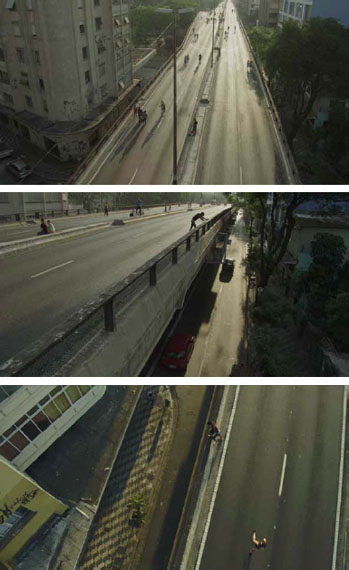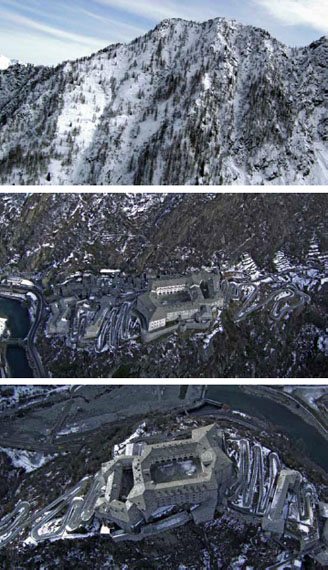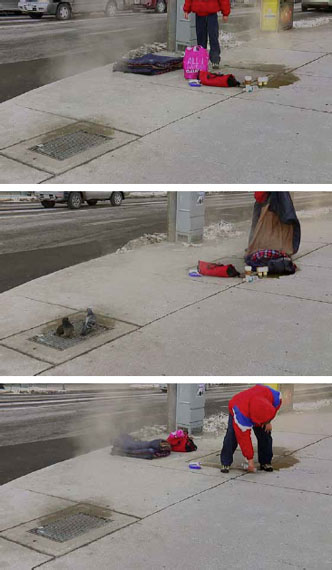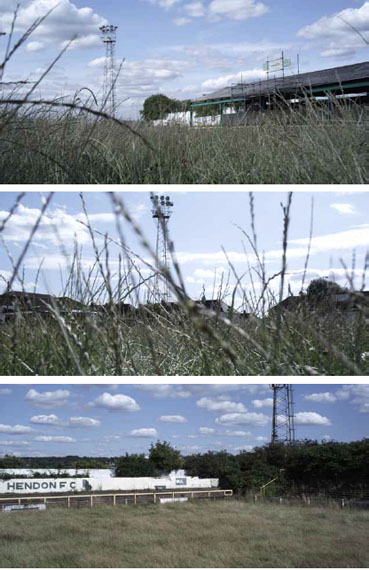
© Mark Lewis
Mark Lewis »
Above and Below
Exhibition: 5 Feb – 17 May 2015

LE BAL
6, Impasse de la Défense
75018 Paris
+33 (0)1-44707550
contact@le-bal.fr
www.le-bal.fr
Wed 12-20, Thu-Sun 12-19

Mark Lewis
"Above and Below"
Exhibition: 5 February – 17 May, 2015
LE BAL is delighted to present the first large exhibition in France of works by Mark Lewis.
Mark Lewis (born 1958) is a Canadian filmmaker, whose work creates a dialogue between film, photography and painting. His short, silent sequence-shots, like the early films of the Lumière brothers, operate by extracting a fragment of reality in a unity of time, space and action. Anything which arises as the images unfold is a product of that random moment of life. Lewis favours the chance emergence of an event, over a constructed narrative, the incursion of something unexpected over the reconstitution of a scene.
His camera homes in on moments of pause or transition, the micro-events and infinitesimal actions of ordinary life. They reveal the inner tensions and also the enigmatic aspect of this familiar theatre. The slow pace of the film emphasizes that sense of mystery and strangeness which emerges from close attention to things.
Concentrating our gaze, slowing it down, so that it both floats and interrogates, is, for Mark Lewis, the most effective way of making us sensitive to the poetry of nothing and conscious of what is involved in the whole. Perhaps those little details underlie a more global mechanism. One is led to wonder what breakdowns they might be clues to. Whether from a great height, or in miniature – in the immutability or the transience of time –, what, above all, we are urged to contemplate is the vestiges of our modern utopias.
The exhibition will show for the first time in Paris a selection of seven films: The Pitch (1998), Cold Morning (2009), Hendon F.C. (2009), Forte! (2010), Cigarette Smoker at the Cafe Grazynka Warsaw (2010), The Moving Image (2011) and Above and Below the Minhocão (2014).
Curators: Chantal Pontbriand (Pontbriand W.O.R.K.S.) et Diane Dufour
The book Mark Lewis - Above and Below will be published by LE BAL to coincide with the exhibition.
304 pages
289 images in colour
Graphic design: Agnès Dahan
Texts by Mark Lewis and Chantal Pontbriand
Published by LE BAL
Distributed by Les Presses du Réel
37 euros
�

"Above and Below" is a reference to the title of a work by Mark Lewis which he made in Sao Paolo in 2014: Above and Below the Minhocão. The film was shot in the city centre and its subject is an elevated motorway that crosses the city. The motorway, nowadays, is closed to traffic on weekday evenings and all day Sunday, when it becomes an urban park populated by walkers and cyclists whose activities are essentially centred around leisure and recreation. The Minhocão is something of a modernist monument. When it was built in 1970, it was, at 3.5 km long, the largest road infrastructure project in South America. Urban sprawl, the ever-increasing presence of the motor car (80,000 cars use the motorway every day), air pollution, noise pollution; all these factors make this material excrescence of modernity a monument not to its glory but almost to its demise, a demise which is the flip side of the original modernist aims of progress, speed, efficient population management and also growth. Above and Below thus represents what, in the reality of the contemporary world, has become of the dreams of an earlier age.
The notion of experience also lies at the heart of Mark Lewis’ work. Most of his works are short films involving the development of a single shot. The camera advances slowly in the shot and gives the impression of time being stretched, even though nothing is in slow motion. Space also seems to be stretched, while the slow movement of the camera as it lingers on the shot “opens” the shot towards what might be called a “spread” image. In this way, the spectator is drawn in, and the impression is intensified by the size of the projection. The films function best when the size of the projection is on the same scale as that of a body contemplating a natural or urban landscape, or a piece of architecture. What is produced is a sensory experience, an experience with the potential to create in the spectator confronted with the work a broadened consciousness of the world.
The camera movements in the work of Mark Lewis and the insistent way in which he uses them set up another process which slightly resembles dizziness - a vertigo that creates a loss of bearings; that opens up a field of possibilities at the same time as it thwarts the usual way in which the body stands, and recognises and experiences its surroundings. In fact, vertigo imposes a new way of looking at the world on the person suffering from it. One is forced to experience the world differently, to acquire an unaccustomed knowledge and perception of it. In Forte! (2010), a panning shot over a chain of mountains of breath-taking beauty ends with a close-up of an old fort, the Forte di Bard in Valle d’Aosta, evoking the military and political history of the place, the frontier wars and the conquest of territory belonging to the Other; the obverse of the idyllic, not to say commercial vision of the modern world – the fort has been turned into a tourist attraction.
In Hendon F.C. (2009), a large circular camera movement pans around its fulcrum, driven by a crane going from high to low point whence it goes plowing through the high grass in the field, and scrutinizes the wasteland. Looking at the work, it is as though you were in a helicopter (or it is as if the images were captured by a drone, something driven by an unknown force) going up and down again and continuing its pursuit through the tall grass. The moving image exploring the field above and below leads to the appearance of another world, a reverse side of the world.
In his early film The Pitch (1998) that will be on view at LE BAL, Mark Lewis addresses the outsiders of this reversed world, the extras. Mark Lewis himself reads a text about the condition of film extras – the people employed to swell out crowd scenes in cinema. Extras have to wait for hours and hours on sets, and are hired at minimum rates with no guarantee of work the next day. By this mise-en-abyme, this film within a film, Lewis displays the working conditions of the medium as part of its content. Lewis criticises working conditions in show business using its own weapons. He mocks the cinema through the cinema, in fact outsmarts it.
Taking impetus from his "manifesto" in The Pitch, Lewis tackles the question of "bare life" in a series of specific pieces including Cigarette Smoker at the Cafe Grazynka Warsaw (2010). There are no camera movements to interrupt the, for the most part, static shot of this restrained film. The Polish workman is quite simply sitting at a cafe table smoking a cigarette for the entire duration of the piece. This film is significant of an important aspect of Mark Lewis’ work, his attention to things which at first sight seem insignificant: micro-actions which hold his attention and even mobilise his affect. These micro-actions, screen-captures of the real, reveal a form of resistance to the vicissitudes of the world, their gratuitous and non-functional nature being in complete contrast to the usual demands of a capitalist economy where everything has to have a use, to be counted, quantified, and marketed. From this attention to detail emerges a “micro-political” attitude.
Cold Morning exemplifies this micro-political attitude. In an eight-minute sequence shot, using a fixed camera, Lewis records a homeless person settled on a city pavement, having taken a break in his vagrant life. Most of the time it is the lower half of his body that we see, and we never see his face, which is hidden by the hood of his red jacket even when he bends down. He is very methodical in the way he arranges his things. First, he lines up all his possessions, on this cold winter’s morning, then he moves away for a moment to get rid of a plastic bag. Some pigeons are squatting on a nearby air vent. Passers-by occasionally cross the screen, a few cars too, although we only see parts of them. The vagrant returns and picks up a brown sleeping bag, which he lifts and shakes like a bullfighter’s cape before spreading it on the ground. Then he picks up his sleeping bag, folds it up again and rearranges it. He puts everything else that he is carrying with him into a red bag (including a pink plastic bag printed with the words ALL I WANT).
In this film as in many others films of Mark Lewis, capitalism and bare life are inextricably bound up with each other in his vertiginous and repeated plunges into real-life and the interstices of real-life. That is where life is, that is where any hope of renewal and a new beginning are to be found. ALL I WANT. Once again, what we are being shown here is the potentiality of life. This intensity which changes things, which wrenches the world out of its apparent immutability, can only be captured by attentive scrutiny, by being, in one word, attention itself. (Chantal Pontbriand)
�
